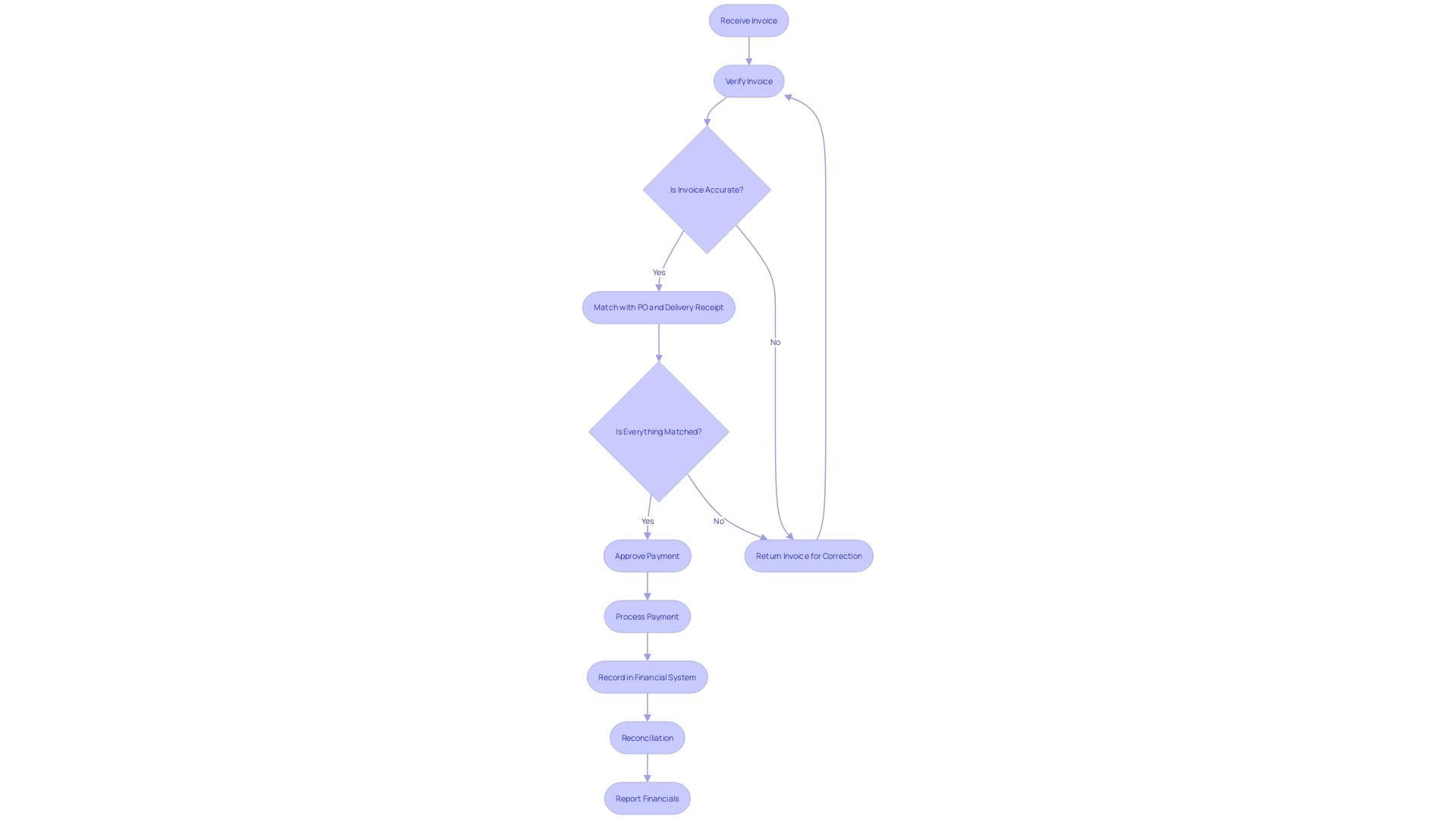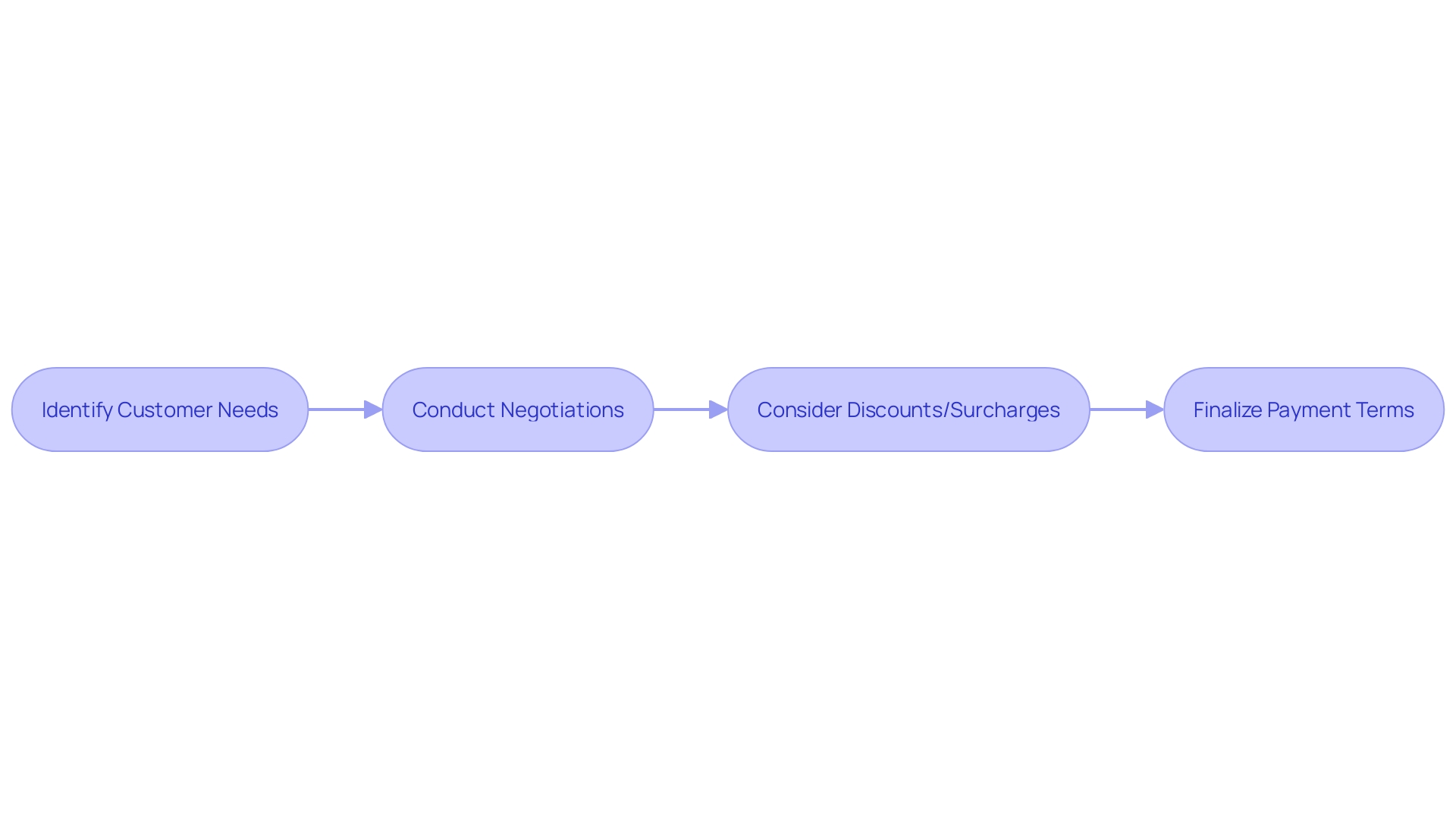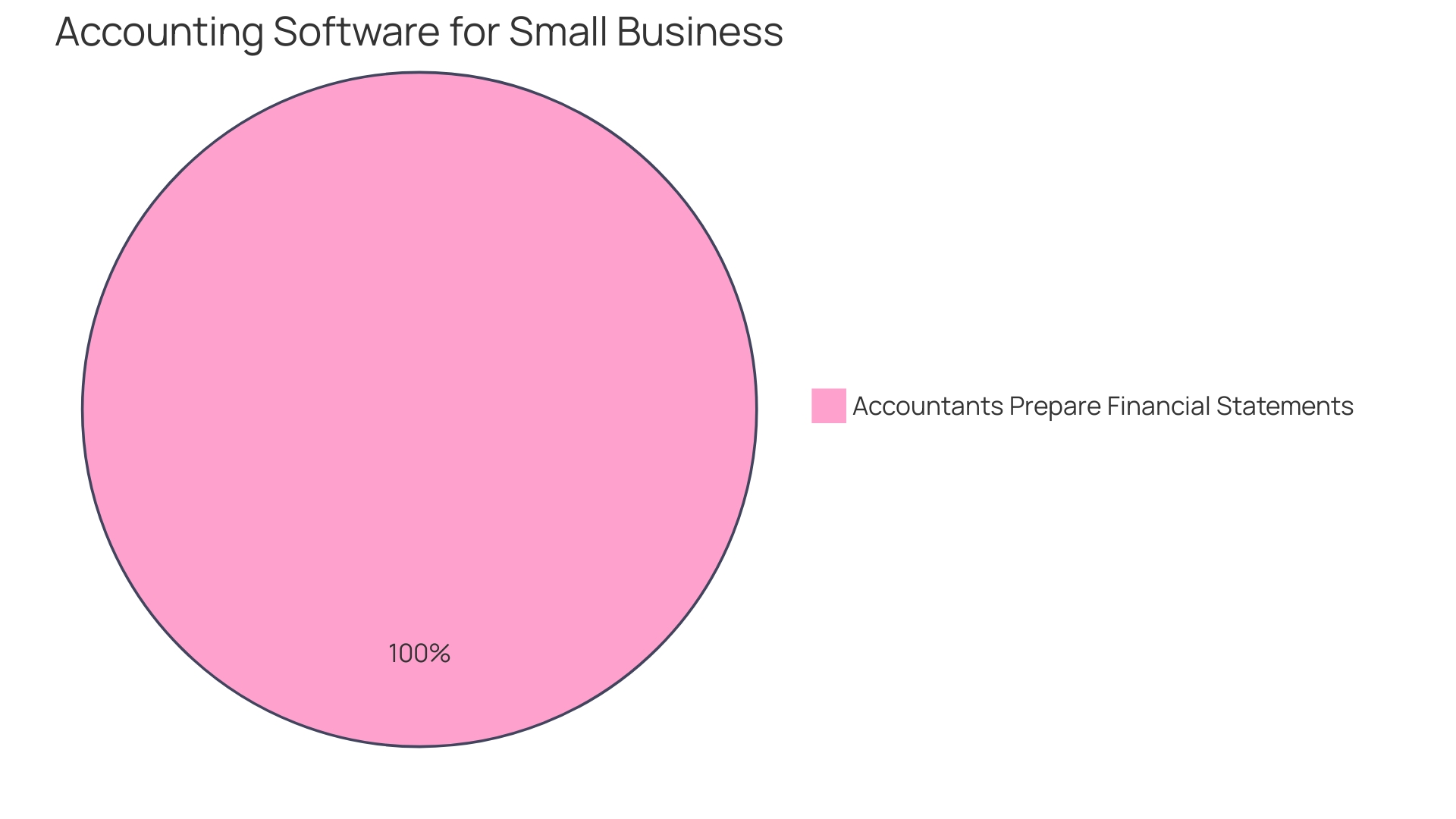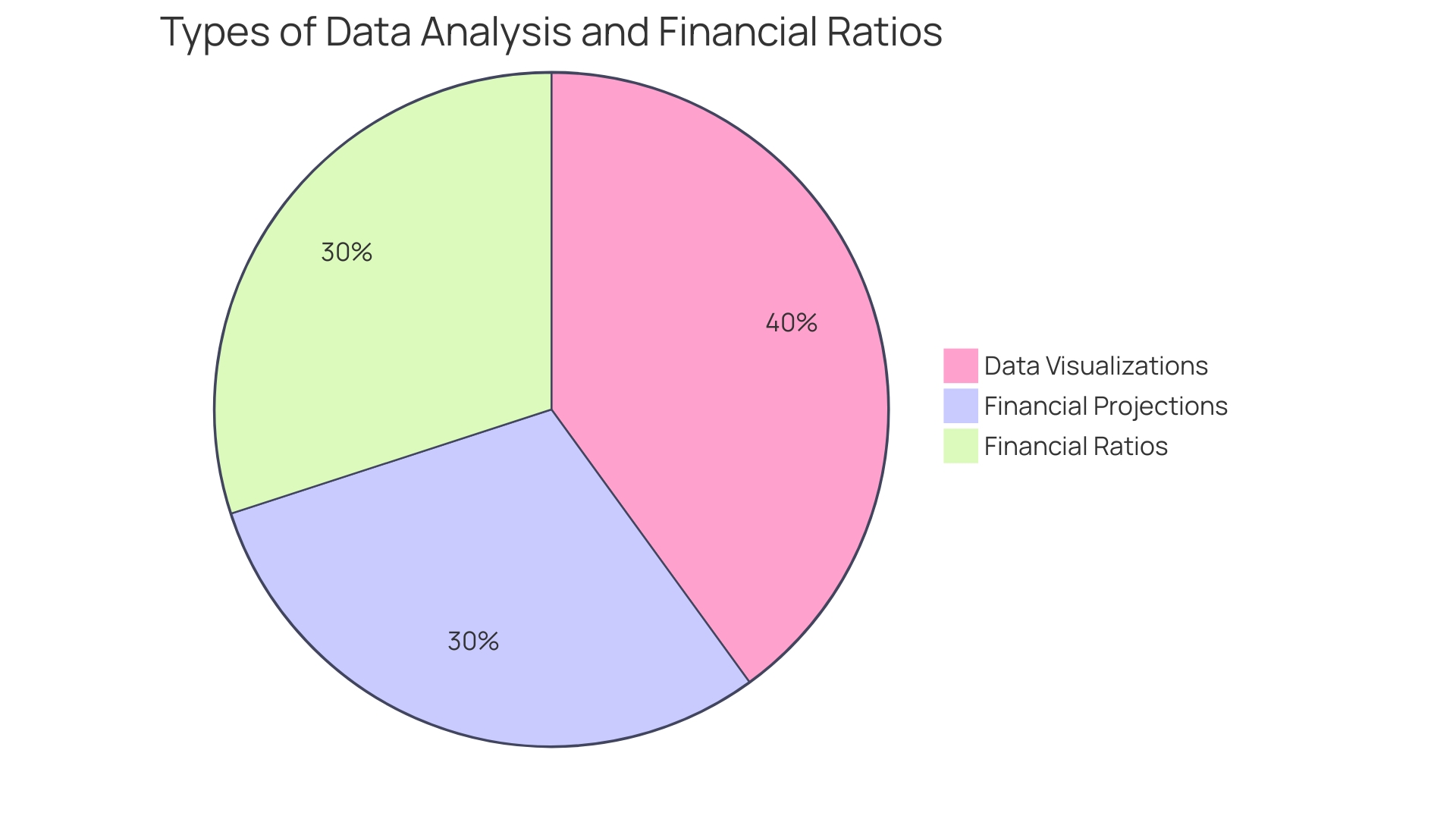Introduction
Accounts Payable is a fundamental aspect of cost accounting that encompasses a business's financial obligations to its suppliers and vendors. This article explores the importance of managing accounts payable effectively and provides insights into key components such as invoice processing, payment terms, and vendor relationship management. It also delves into the challenges faced in accounts payable management and offers best practices for optimizing financial operations.
Additionally, the article highlights the significance of understanding financial ratios and references further reading materials for enhancing cost accounting strategies and staying informed about the latest financial tools and techniques. By implementing these practical solutions, CFOs can navigate the complex landscape of accounts payable and drive the financial stability and growth of their organizations.
What is Accounts Payable?
Accounts Payable, a vital element within the cost accounting framework, embodies the financial obligations a business incurs through the acquisition of goods or services from its suppliers and vendors. Yet to be settled, these obligations represent short-term liabilities expected to be cleared typically within a one to three-month period. Cost accounting, extending beyond the mere tracking of these liabilities, encompasses various types, each surfacing within financial reports, effectively catering to diverse industrial sectors like steel production with its multifaceted departmental expenses.
Understanding cost accounting's role is quintessential for steering a company's financial course. Unlike financial accounting, which captures all monetary transactions and summarizes them through financial statements such as balance sheets and income statements, cost accounting zeroes in on accumulating and managing costs over defined quantities and durations. It is designed to flag discrepancies between expected (standard) and actual costs, hence empowering businesses with the insights to optimize and control expenses.
In today's economic climate, where accurate financial data interpretation is paramount, the distinction between accounting and bookkeeping becomes clear. Bookkeeping focuses solely on the meticulous recording of financial transactions. In contrast, accounting is an overarching discipline that entails both record-keeping and the analytical interpretation of financial data to inform strategic business decisions, impacting both present and future financial health.
The imperative to manage Accounts Payable efficiently underscores the broader objective of accounting—to provide a foundation for robust financial stewardship.

Importance of Accounts Payable
Managing a company's accounts payable is not just about paying bills; it's a strategic function crucial for optimizing cash flow and cementing robust supplier relationships. By effectively overseeing accounts payable, businesses ensure they can procure essential goods and services on credit terms that align with their operational cadence, thereby promoting continuity and operational efficiency.
The importance of this function is underscored by the intricate balance between maintaining liquidity and maximizing the value derived from each supplier interaction. For example, robust supplier relationship management can yield tangible benefits such as price reductions and cost-saving opportunities. These are achieved through collaborative efforts and open communication, which may include discussing ways to remove excess costs from the production process.
Moreover, the role of an accounts payable clerk extends beyond transaction processing to encompass expense management and financial compliance. This role is pivotal in small businesses where each team member often wears multiple hats. The clerk's contributions facilitate informed financial decision-making, which is essential for the company's overall financial health.
In the context of cash flow management, it's essential to understand the interplay between cash flow and profit. Effective accounts payable management helps maintain a healthy cash flow, preventing the dire consequences that a cash shortage can bring to even the most successful businesses. It is the strategic maneuvering of cash flow that can make the difference between a thriving business and one that struggles to meet its obligations.
In essence, the accounts payable function is a critical component of a company's financial backbone, influencing liquidity, supplier dynamics, and the broader financial strategy. By reevaluating expenditures and prioritizing payments in line with strategic goals, businesses can enhance their financial stability and pave the way for sustainable growth.
Key Components of Accounts Payable
The Accounts Payable (AP) department acts as the financial linchpin of a business, ensuring that all outgoing payments are managed with precision. It's not just about paying bills; AP clerks play a pivotal role in expense management and reporting, which is critical for maintaining the financial health of small businesses. They are tasked with managing cash flow by processing invoices swiftly and accurately, which aligns with the zero-based budgeting system used by successful firms like YNAB, where every dollar is accounted for.
An AP clerk's duties encompass various critical functions. They are responsible for the verification and reconciliation of invoices against purchase orders, maintaining detailed and up-to-date vendor records, and adhering to payment terms that safeguard the company's cash position. These functions are essential for ensuring financial compliance and control, much like the meticulous data tracking that helps businesses gain insights and improve their website's functionality.
The qualifications for an effective AP clerk include proficiency in financial software and a keen eye for detail, which can prevent costly errors and save the company from unnecessary expenses. By managing vendor relationships and handling inquiries, they foster trust and reliability, essential for long-term partnerships and smooth operational flow. This role is becoming increasingly important as regulatory landscapes evolve, as seen with the IRS's efforts to streamline reporting requirements and enhance compliance.
In today’s economic climate, where businesses navigate through challenges like inflation and high-interest rates, an AP clerk's ability to manage expenses and support the company's financial objectives is more crucial than ever. Therefore, investing time in developing robust accounting practices, including an efficient AP process, is not just a matter of compliance but a strategic move towards business resilience and success.
Invoice Processing and Management
Mastering invoice processing is vital for maintaining robust accounts payable operations. It begins with the receipt of an invoice, which is more than just a simple request for payment. An invoice is a structured document pivotal to business transactions, detailing the specifics of services rendered or goods provided, with a unique invoice number for tracking, and clearly stated payment terms to guide timely financial exchanges.
Processing the invoice entails meticulous verification against corresponding purchase orders and delivery receipts, ensuring each charge aligns with what was agreed upon. This step is more than a formality; it's a safeguard against errors that could disrupt cash flow and affect profitability.
Businesses face a challenge in managing the complexity and volume of invoices, particularly during peak operational times. For instance, a bustling hotel like Travel Charme Strandhotel Bansin, which caters to approximately 250 guests nightly, must handle numerous transactions flawlessly amidst the high demand of vacation season.
In the context of increased information reporting requirements, as indicated by recent IRS statements, ensuring accurate and timely invoice management is also a compliance matter. The IRS has emphasized the necessity of meeting taxpayers where they are to facilitate compliance and ease the reporting process, a principle that equally applies to the proper handling of invoices.
In light of these complexities, it's clear that effective invoice management is not just about paying bills—it's about sustaining the financial health and compliance of a business. With careful attention to detail and strategic use of technology, companies can enhance their accounts payable processes, thus securing their financial stability and growth.

Payment Terms and Terms of Sale
Mastering the dynamics of payment terms and conditions of sale is a cornerstone of effective accounts payable administration. These elements set the definitive timeline for fulfilling financial obligations and dictate the scenarios where discounts or surcharges may come into play. Engaging in astute negotiations for advantageous payment terms holds the potential to markedly influence your organization's cash flow and bottom-line results.
By aligning your payment strategies with the understanding that cash flow is the lifeblood of a business, ensuring its vitality, and differentiating from mere profit, you empower your company to optimize operational efficiency and financial longevity. This approach is supported by the tenets of ASC 606, which clarifies the identification of a customer in transactional processes, an essential factor for businesses aiming to increase profitability through strategic payment processing. Moreover, anecdotes from diverse industries, including legal practices and hospitality firms, underscore the importance of a nuanced approach to payment solutions, emphasizing the need for a system that resonates with the company's ethos and client base.
By integrating these insights into your payment term negotiations, you can craft a robust framework that not only respects your company's financial health but also contributes to a sustainable business model.

Vendor Records and Relationship Management
The role of an accounts payable clerk is multifaceted and extends far beyond mere invoice processing; it is a linchpin in the financial health of any small business. This individual is tasked with ensuring that all financial transactions are executed accurately and punctually. A crucial aspect of this role involves meticulous vendor record maintenance, which encompasses not only the recording of essential vendor details, such as contact information and payment terms, but also the preservation of a historical ledger of transactions.
Effective supplier relationship management, a key skill for procurement and supply managers, hinges on trust, transparency, and mutual communication. By strengthening these relationships, businesses can unlock numerous advantages including cost reductions and superior service levels. A collaborative approach with vendors, characterized by shared forecasting and open dialogue, can result in leaner production costs and other supply chain efficiencies.
Recent industry trends underscore the significance of accounts payable proficiency. Gartner's projections indicate that by 2026, the investment in accounts payable automation and supplier electronic invoicing software markets will approach $1.75 billion, marking a 14% CAGR from approximately $925 million in 2021. Furthermore, a survey by Ardent & Partners reveals that 66% of businesses deem the accounts payable function as indispensable to their operations.
However, the stakes are high, as inaccuracies in purchase order information precipitate 49% of disputes, according to CFO.com. Thus, the meticulous management of accounts payable is not only a matter of compliance but also a strategic element that influences a business's ability to negotiate favorable terms with vendors and optimize overall operational expenditure.
Challenges in Accounts Payable Management
Accounts payable management is a crucial aspect of a small business's financial success. The role of an accounts payable clerk is multifaceted, encompassing the meticulous processing of invoices to ensure accuracy and the strategic management of vendor relationships. This position is not just about paying bills; it's about safeguarding the company's financial compliance, controlling expenses, and contributing to a comprehensive expense management strategy.
Effective invoice processing is foundational to managing cash flow and liquidity. By ensuring that invoices are handled accurately and promptly, an accounts payable clerk helps avoid late payments and discrepancies that could lead to financial strain or damage vendor relationships. Furthermore, this precision in handling transactions strengthens the business's ability to comply with financial regulations and reporting standards.
An accounts payable clerk also plays a pivotal role in fostering robust vendor relationships. By managing inquiries and interactions professionally and efficiently, they help maintain a network of reliable suppliers, which is vital for the operational success of any small business.
The qualifications for a successful accounts payable clerk go beyond basic bookkeeping. They need a keen eye for detail, strong organizational skills, and the ability to navigate various financial platforms. As businesses evolve, leveraging technology becomes increasingly important.
Utilizing systems that provide enhanced functionality, such as electronic invoicing and automated data entry, can dramatically improve the efficiency of the accounts payable process.
It's worth noting that the accounts payable sector is undergoing significant changes. With a projected compound annual growth rate of 14% by 2026 in the accounts payable automation and supplier electronic invoicing software markets, it's clear that businesses are recognizing the importance of updating their systems to remain competitive and efficient.
In conclusion, the accounts payable clerk is integral to the financial health of a small business. By combining thorough financial transaction processing with proactive vendor management and compliance oversight, they help pave the way for stable and successful financial operations.

Best Practices for Accounts Payable Management
For small businesses, the role of an accounts payable clerk is critical in managing expenses and ensuring financial compliance. The clerk's expertise in processing invoices promptly and accurately not only streamlines the financial workflow but also supports expense management and reporting. By overseeing vendor relationships and handling inquiries with finesse, the clerk maintains essential communication channels and contributes to the company's financial health.
Key qualifications for this role encompass a blend of technical skills and a deep understanding of cost-accounting principles, enabling the clerk to perform duties that align with the organization's financial strategies and controls. Considering the economic landscape, where inflation and borrowing costs are impactful, the efficiency of accounts payable processing takes center stage. With the projection that spending on accounts payable automation and e-invoicing software will reach nearly $1.75 billion by 2026, businesses are recognizing the necessity to invest in modernizing their accounts payable systems.
This investment not only prepares companies for future challenges but also ensures they are equipped with tools that prevent vendor lock-ins and outdated practices. In light of these trends, implementing best practices such as automated payment systems and regular vendor reconciliations becomes more than a convenience—it's a strategic imperative that promotes accuracy, efficiency, and compliance, driving the financial performance to new heights.
Financial Ratios for Managing Accounts Payable
Understanding and managing financial ratios is crucial for a company's accounts payable efficacy and overall fiscal stability. Key indicators such as the accounts payable turnover ratio reveal how swiftly a business settles its debts, which can be indicative of its negotiation acumen and creditworthiness. The average payment period ratio also sheds light on the company's payment habits and cash management proficiency.
Meanwhile, the cash conversion cycle metric offers insights into the time it takes to convert resource inputs into cash flows, highlighting the efficiency of a company's operational and financial processes.
By diligently tracking these ratios, businesses can pinpoint opportunities for enhancing their accounts payable strategies. For instance, an extended average payment period might suggest a need for better terms negotiation with suppliers or an evaluation of existing payment processes. On the other hand, a shortened cash conversion cycle could indicate a more robust turnover of inventory and receivables, leading to improved liquidity.
The integration of advanced technologies and automated solutions can significantly aid in refining these processes. Just as enterprises have embraced performance technologies to monitor and analyze website usage for business insights, applying similar tools to scrutinize and manage financial ratios can lead to more informed decision-making and streamlined operations.
Real-world examples, such as Hershey's efforts to enhance its accounts receivable (AR) through automation, demonstrate the tangible benefits of adopting such technologies. After facing a downturn characterized by sales decline and profitability issues, Hershey's revitalized its financials by modernizing its AR processes, thus improving cash flow and operational efficiency.
In the context of accounts payable management, the adoption of such innovative approaches, combined with a keen understanding of financial ratios, can facilitate a more dynamic and resilient financial framework, ensuring a company's ability to adapt and thrive in an ever-evolving economic landscape.

Further Reading and References
Cost accounting is a vital component of a company's financial framework, providing insights into the expenses involved in production and distribution. It guides pricing, budgeting, and profitability decisions. To enhance your cost accounting strategies, it's crucial to foster a cost-aware culture within your organization.
This means integrating cost considerations into your product development cycle as a non-functional requirement, akin to system performance or reliability. Additionally, the responsibility for managing costs should be spread across the organization, not just isolated within the finance department.
Understanding the distinction between accounting and bookkeeping can further refine your financial management. While bookkeeping focuses on the systematic recording of financial transactions, accounting encompasses a broader scope, analyzing and interpreting financial data to inform business decisions. Accountants generate critical financial statements, such as cash flow statements, balance sheets, and income statements, which are indispensable for small businesses in steering their fiscal direction.
Leveraging the latest accounting software can streamline this process, and staying informed with recent developments in the field is essential. For an in-depth exploration of best practices in accounting and bookkeeping, and to keep abreast of the latest financial tools and techniques, consider delving into current literature and guidelines that address these aspects comprehensively.
Conclusion
Effective accounts payable management is crucial for optimizing cash flow, maintaining strong supplier relationships, and ensuring financial compliance. By implementing best practices and understanding financial ratios, CFOs can drive the financial stability and growth of their organizations.
Managing accounts payable goes beyond paying bills; it is a strategic function that promotes operational efficiency and continuity. By overseeing payment terms and vendor relationships, businesses can secure cost-saving opportunities and price reductions. The role of an accounts payable clerk extends to expense management and financial compliance, contributing to the overall financial health of the company.
Key components of accounts payable include meticulous invoice processing and management. By leveraging technology and strategic invoice management, businesses can enhance their financial stability and growth.
Payment terms and terms of sale play a vital role in accounts payable administration. Aligning payment strategies with the understanding that cash flow is crucial empowers organizations to optimize operational efficiency and financial longevity.
Vendor records and relationship management are critical for accounts payable. Meticulous vendor record maintenance and effective supplier relationship management can lead to cost reductions and superior service levels.
Accounts payable management faces challenges in maintaining financial compliance, controlling expenses, and fostering strong vendor relationships. By leveraging technology and staying updated with industry trends, businesses can modernize their accounts payable systems and remain competitive and efficient.
Implementing best practices, such as automated payment systems and regular vendor reconciliations, is crucial for accuracy, efficiency, and compliance in accounts payable management.
Understanding and managing financial ratios is essential for accounts payable efficacy and fiscal stability. By diligently tracking key indicators and leveraging advanced technologies, businesses can refine their accounts payable strategies and make informed decisions.
In conclusion, effective accounts payable management is crucial for optimizing financial operations, maintaining strong supplier relationships, and driving the financial stability and growth of organizations. By implementing practical solutions and understanding financial ratios, CFOs can ensure the long-term success of their organizations.




